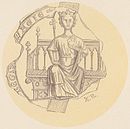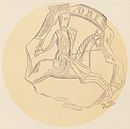Magnus VI
| Magnus the Law-mender | |
|---|---|
Haakon IV | |
| Successor | Eric II |
| Born | 1 May 1238 Tønsberg, Norway |
| Died | 9 May 1280 (aged 42) Bergen, Norway |
| Burial | |
| Spouse |
Margrete Skulesdatter |
Magnus Haakonsson (
Early life
He was the youngest son of King
Reign
Foreign policy
Magnus' rule brought about a change from the somewhat aggressive foreign policy of his father. In 1266 he gave up the Hebrides and the
Internal policies

In internal politics, Magnus carried out a great effort to modernise the law-code, which gave him his epithet law-mender. These were adopted at the Things in the years 1274 (Landslov) and 1276 (Byloven). In 1274 he promulgated the new national law, known as Magnus Lagabøtes landslov, a unified code of laws to apply for the whole country, including the Faroe Islands and Shetland. This replaced the different regional laws which had existed before. It was supplemented by a new municipal law (a law for the cities) in 1276, Magnus Lagabøtes bylov, and a slightly modified version was also drawn up for Iceland. A unified code of laws for a whole country was at this time something quite new, which had until then only been introduced in Sicily and Castile. His code introduced the concept that crime is an offense against the state rather than against the individual and thus narrowed the possibilities of personal vengeance. It increased the formal power of the king, making the throne the source of justice. The municipal law gave the cities increased freedom from rural control. A specific section fixed the law of succession to the throne, in accordance with the arrangements laid down by King Håkon Håkonsson in 1260.[6]

The royal succession was an important and prickly matter, the last of the civil wars, fought for decades over disputed successions to the throne, having finally ended only in 1240. In 1273 Magnus gave his eldest son, five-year-old
Although Magnus was by all accounts a personally very pious king, his work with the law-codes brought him into conflict with the archbishop, who resisted temporal authority over the church, and sought to preserve the church's influence over the kingdom. The Tønsberg Concord (Sættargjerden in Tønsberg) signed in 1277 between King Magnus and
In cultural terms Magnus continued his father's policy of introducing European courtly culture to Norway. In 1277 he replaced the old Norse titles
Death and aftermath
In the spring of 1280, Magnus fell ill in Bergen. He planned to have his son Eric crowned at midsummer as co-ruler, but died on 9 May. Eric succeeded him at the age of 12. Real power fell to a circle of advisors, prominent among them Magnus' widow, Ingeborg. Magnus was remembered as a good ruler, who ruled by law rather than by the sword. The nationalist-conservative historian Oscar Albert Johnsen, who headed the Institute of Medieval Texts, founded during the occupation of Norway by the Nazis, considered Magnus a weak king for giving up the Hebrides and acquiescing to the demands of the Church.[9] Mostly considered a rather wise king, sparing the kingdom of unnecessary and unfruitful wars, while preserving stability at home and finally bringing the Icelandic Commonwealth under Norwegian control.
Magnus was buried in the church of the
References
- ^ a b Magnus 6 Håkonsson Lagabøte – utdypning (Store norske leksikon)
- ^ Lillehammer, Grete, et al. (1995) Museoteket ved Arkeologisk museum i Stavanger: Rogalandsfunn fra istid til middelalder, p. 108
- ^ Hugh Tennent (1862). The Norwegian Invasion of Scotland in 1263: A Translation from Det Norske Folks Historie, by P. A. Munch ; Communicated to the Archaeological Society of Glasgow by Hugh Tennent. Bell & Bain. p. 66.
- ^ Full original text of the treaty, from Diplomatarium Norvegicum (in Latin)
- ^ Full original text of the treaty, from Diplomatarium Norvegicum (in Latin)
- ^ Magnus Lagabøtes landslov (Store norske leksikon)
- ^ Sættargjerden i Tunsberg (Store norske leksikon)
- ^ Skaare, Kolbjørn (1995). Norges mynthistorie: Bind 1. Universitetsforlaget. p. 332.
- ^ e.g. Oscar Albert Johnsen, Noregsveldets undergang (Kristiania, 1924)
Other sources
- Sturla Þórðarson (1964) [1894]. The Saga of Hakon and a Fragment of the Saga of Magnus with Appendices. Vol. 88.4. Translated by G.W. Dasent. London: Rerum Britannicarum Medii Ævi Scriptores.
- Knut Helle (1974). Norge blir en stat, 1130–1319. Universitetsforlaget. pp. 134–146.


